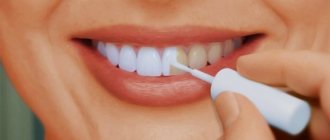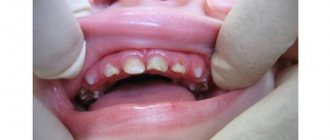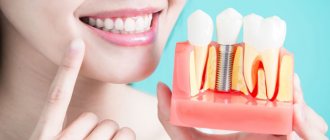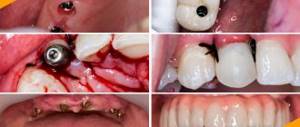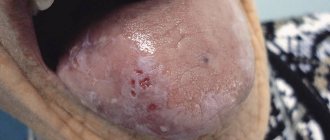It is not easy to damage enamel - it mainly occurs as a result of carious processes or mechanical stress (for example, when choosing a toothbrush with hard bristles or abusing whitening procedures at home), with a lack of vitamins or the wrong food, with immune or endocrine disorders of the body. There is also the concept of “hypoplasia” - this is a congenital anomaly in which there is the presence of very thin enamel or its complete absence.
Strengthening teeth is possible both at home and in a dental office. However, there is one condition - only a doctor should prescribe treatment. Specialists at the Smile-at-Once center conduct a thorough diagnosis of the condition of the patient’s tooth enamel, identify the causes of the problem, and then draw up a treatment plan - as a rule, it includes procedures that are carried out in the clinic, as well as measures that the patient himself must carry out during treatment. at home.
Functions of the protective layer
Tooth enamel is the hardest tissue in the body, but at the same time, it is also the most fragile. It covers the other layers of the tooth, namely dentin and pulp. Enamel as a protection protects soft tissues from mechanical, temperature and chemical influences.
The protective layer is translucent and consists of various mineral substances. The structure depends on the characteristics of the body, the foods consumed and the process of assimilation of useful components.
On a note! Some people have a naturally thin protective layer on their teeth, making it susceptible to a variety of damage and disease.
The main function of enamel is to protect the soft tissues of the tooth from external irritants. It also ensures that the crown retains its shape, which makes full chewing possible.
Due to the hardness of the enamel, food is crushed and bitten.
What materials are they made from?
Most people, especially older people, are accustomed to associating the word “crown” with a gold tooth, but modern medicine has advanced so much that the prosthetic products used are practically no different from real teeth.
Reference! The main difference between such designs is the material, the type of which will determine the service life and external aesthetics of the manufactured crown.
Metal
Despite the fact that metal crowns are still used, in the modern world such structures should long ago become a relic of bygone days. Even such significant advantages as high wear resistance and incredible strength do not cover their one, but impressive drawback - an extremely unaesthetic appearance.
In addition, it is quite difficult to place a metal crown on a damaged tooth segment. And finding a clinic that uses such outdated restoration methods is not so easy.
There are two main types of metal crowns:
- from alloys of precious metals : prostheses made from the most popular precious metal - gold. There are also silver structures, but in terms of their characteristics they are significantly inferior to gold prostheses, so at present they are almost never installed;
- from alloys of base metals : crowns made of titanium, which do not have a long service life, but at the same time boast an affordable price.
Gold crowns
Titanium crowns
Metal ceramics
A distinctive feature of such designs is the use of a ceramic coating, which in its appearance resembles real enamel. Metal-ceramic crowns are durable, and their cost is relatively low, so among all the proposed options, these prostheses are the most optimal in terms of price and quality ratio.
There is also a significant drawback: the lack of translucency of the coating when fixed to the front teeth reveals the artificiality of the design. After installation, a gap remains between the gum and the crown, in which the metal base of the product is visible. Because of this, an unaesthetic dark stripe is formed.
There are two varieties :
- on alloys of precious metals : made on the basis of the metal we have already discussed - gold. They differ from ordinary metal products in a more advantageous appearance, but at the same time they are just as wear-resistant and hypoallergenic;
- on alloys of non-precious metals : an alternative to expensive gold products are models made from an alloy of nickel, cobalt and chromium. This material is highly durable, however, over time, the gums under the prosthesis become very dark, and some people may even develop allergic intolerance.
Gold-based metal ceramics
Combined
Metal-plastic
A special plastic overlay is attached to the metal base of the prosthesis, which imitates the structure of tooth enamel.
Such crowns quickly lose their original appearance, change shade and do not have high strength. However, the affordable price and the possibility of rapid production make it possible to use such products as temporary prosthetics.
Causes of destruction
Under the influence of a number of internal and external factors, the enamel wears out and becomes damaged. This affects the appearance, feel, and health of the entire oral cavity and gastrointestinal tract.
Injury to enamel is one of the causes of caries, pulpitis, darkening of teeth and their increased sensitivity.
What causes damage:
- poor oral hygiene;
- microflora disturbance, predominance of pathological microorganisms;
- diseases of the gastrointestinal tract (reflux esophagitis, gastritis);
- smoking, drinking energy drinks and mineral water with dyes;
- pathological bite, absence of one or more teeth;
- injuries and mechanical damage;
- bruxism, the habit of holding foreign objects in the teeth (matches, threads);
- eating sweet and sour foods;
- bleaching at home using aggressive abrasives and acids;
- lack of regular dental treatment;
- active accumulation of hard dental deposits.
The risk group includes people whose activities involve the possibility of injury (athletes, builders). Enamel can also be damaged by taking certain medications. The presence of prostheses is also a risk factor for the destruction of hard tissues.
Indications for installation
Prosthetics are prescribed by the attending physician in cases where:
- you need to straighten a crooked tooth or change its size/shape/shade;
- fluorosis was detected;
- the inflammatory process damaged more than half of the coronal part of the tooth, and the pulp was removed;
- there is a need to restore a damaged or lost tooth;
- Due to the incorrect location and size of the teeth, dental anomalies are observed. Contraindications include:
- advanced stages of periodontal disease;
- allergic intolerance to the material used;
- malocclusion;
- thinned tooth walls;
- low location of the coronal part of the segment.
Innovative method
Dental enamel implantation is restoration at the molecular level. The procedure is currently considered the most effective and high-quality.
The technique consists of applying a special agent (an analogue of the protein amelogenin), which is part of the protective layer, to the surface of the problem unit.
During the process of damage, this substance is lost, so during implantation it is artificially supplied. After the procedure, the tooth returns to its former shape and even becomes more attractive. The implanted tissue does not differ in color from the natural one.
On a note! Recovery continues for about a month after the procedure, but the tissue is able to fully perform all the functions of tooth enamel immediately.
This result is achieved due to the formation of a crystal lattice after the protein enters the pores.
Indications for implantation will be the following conditions:
- darkening of the tooth (when other methods do not work);
- fluorosis;
- mechanical damage;
- pathological bite (mild severity);
- irregular crown shape;
- large interdental spaces.
On a note! The procedure is a minimally invasive method and therefore does not require pain relief, which significantly narrows the list of contraindications.
The video shows the process of dental enamel implantation.
Is it possible to carry out the procedure at home?
The company that sells the enamel implantation product offers not only drugs for professional use in dentistry, but also products for home use. For example, the InnoDent De-Senz set. This complex is suitable for all people with sensitive enamel, non-carious dental lesions (wedge-shaped defect, erosion, hypoplasia, fluorosis), as well as pregnant and lactating women. The product must be used once, i.e. One application will be enough. The volume of the bottle is enough to treat 32 teeth. After 3 days, sensitivity will decrease, but the maximum effect should be expected only after a month. The result lasts from 9 months to 3 years.
This complex is suitable for all people with sensitive enamel
Advantages and disadvantages
Experts attribute the following factors to the advantages of the technique:
- high aesthetics;
- elimination of cosmetic defects of any complexity;
- possibility of bite correction;
- return of soft tissue protection;
- painlessness;
- durability, restoration can last until the end of life.
The only disadvantage of implantation will be its high cost, compared to other restoration options. This is an innovative method of recovery, and it has no categorical contraindications or significant disadvantages.
Causes of development of tooth enamel erosion and methods of treating pathology.
Come here if you are interested in how dangerous cracks in tooth enamel are.
At this address https://www.vash-dentist.ru/protezirovanie/nesemnyie-p/stiranie-zubov.html we will talk about the treatment of pathological tooth abrasion.
Alternative methods
For minor defects in tooth enamel, enamel restoration methods such as remineralization, fluoridation, composite restoration, microprosthetics of front teeth with veneers and lumineers can be used. These methods already have their contraindications and disadvantages.
Remineralization
Remineralization is carried out to restore the balance of minerals. It is carried out by applying preparations containing fluoride and calcium to the problematic elements of the jaw.
The product can be applied to the teeth or placed in dental trays, which are placed on the bone organs of the upper and lower jaw.
The preventive procedure prevents the development of carious cavities and can be performed outside the walls of the clinic, for which individual mouth guards are made.
Indications:
- before bleaching;
- wedge-shaped defect;
- pregnancy period;
- before installing veneers and lumineers;
- enamel erosion and other non-carious defects.
Frequently used preparations for remineralization are Remodent and Rox gel. Their effect can be enhanced by supplementing the procedure with electrophoresis. This helps better penetration of substances such as magnesium, phosphorus, and calcium into hard tissues.
Fluoridation
The method is used to prevent caries. The procedure involves treating the problem units with a fluoride gel. A protective film forms on the enamel, which continues to release fluoride for some time.
Deep fluoridation is considered more effective, when the elements of the jaw row are covered with liquids containing calcium and fluorine.
The procedure is not performed for untreated caries. Before carrying out professional cleaning is carried out.
The benefit of the technique is to prevent caries, reduce tooth sensitivity, and preserve nutrients in the enamel, which makes it more durable.
Filling material
Artistic restoration with composites is performed for chips, cracks, stains, and abrasion of teeth. The technique is contraindicated only for night teeth grinding. Light-curing composite materials are used for restoration.
During the procedure, the dentist applies photopolymer mass in layers, creating the desired shape. During one visit, it is possible to restore several crowns at once.
The restoration can last more than 15 years, but polishing must be done every 2 years.
The purpose of the method of dental physiotherapy with calcium and the stages of the procedure.
In this publication we will talk about the peculiarities of the course of tooth necrosis.
Read here about the dangers of dental fluorosis in children.
Veneers and Lumineers
Veneers are thin composite and ceramic shells that are placed on pre-ground front teeth. Lumineers are distinguished by the fact that they are even thinner and do not require extensive grinding of the enamel.
Products are indicated for aesthetic defects, increased tooth abrasion, small chips and cracks, and unsatisfactory color. The technique is contraindicated for bruxism, pathological occlusion, caries and thin enamel.
Microprostheses can last up to 10 years, ultra-thin lumineers - up to 20 years. Using this method, you can restore the attractiveness of your teeth, completely transforming your smile line.
Recovery at home
Home methods for restoring enamel involve the use of medicated toothpastes, massage of the gums to improve tissue nutrition, the use of folk remedies, and adherence to healthy eating rules.
Folk remedies include rinsing the mouth with herbal decoctions, applying a mixture of garlic and beets to the gums, and applications with the addition of tea tree oil. To lighten enamel, you can use baking soda, hydrogen peroxide, and lemon juice.
On a note! Home remedies for lightening damage enamel and are highly discouraged. They give a temporary effect, after which the teeth darken even more.
Representatives of toothpastes for strengthening enamel:
- Splat Biocalcium;
- Glister;
- Lakalut Extra Sensitive;
- Colgate Sensitive Pro-Relief.
Gum massage is performed while brushing your teeth with a brush or finger. You need to make circular movements, several times near each tooth. This improves tissue nutrition, promoting normal blood circulation.
Products that are beneficial for enamel will be fresh vegetables and fruits, seafood, and fish. Dentists recommend eating an apple or carrot every day, which cleans crowns well.
To maintain dental health, it is important not to forget to rinse your mouth with water or a special mouthwash after each meal.
Types of metal crowns
Solid metal crown - made according to an individual impression of the patient. The precision casting method allows you to reproduce the desired anatomical shape of the tooth. Thanks to this, the risk of incomplete adhesion and penetration of bacteria under the crown is eliminated. Cast crowns can be:
- with spraying
- without spraying
- with ceramic lining
A stamped metal crown is a budget product of standard sizes, the desired shape is given by processing with a special machine.
Such crowns can be installed if at least a third of the tooth remains intact.
Price issue
| Method | Price (in rubles) |
| Fluoridation | Glubokoe - from 1200 Simple 1 tooth - from 300 |
| Remineralization | 1 jaw – from 1500 |
| Restoration with filling material | From 1000 |
| Veneers | From 10000 |
| Lumineers | From 25000 |
| Implantation | From 10000 |
Reviews
Enamel implantation is not suitable for everyone, but those who have tried this method of restoring teeth on themselves are convinced of the good aesthetics and reliability of the restoration.
But, along with positive opinions, this method also receives negative reviews. You can share your own impressions about the enamel implantation procedure in the comments below.
If you find an error, please select a piece of text and press Ctrl+Enter.
Tags: tooth enamel implantation
Did you like the article? stay tuned
Previous article
Causes of suture dehiscence after dental implantation and how to avoid the consequences
Next article
Frankly about the pros and cons of advanced dental implantation methods
Care after restorative bleaching
The features of oral care after restorative teeth whitening are quite simple: you should regularly carry out hygiene procedures using a toothbrush, paste and dental floss. Microdentures are much less susceptible to staining than enamel, however, to maintain the whiteness of your smile for as long as possible, you should reduce your consumption of coloring foods and drinks, such as coffee, tea, wine and chocolate. In addition, it is necessary to monitor the load, that is, of course, you should not use your front teeth to bite threads, chew pencils and bite too hard food. With proper care and regular visits to the dentist, the patient can maintain a dazzling smile for a long time.

